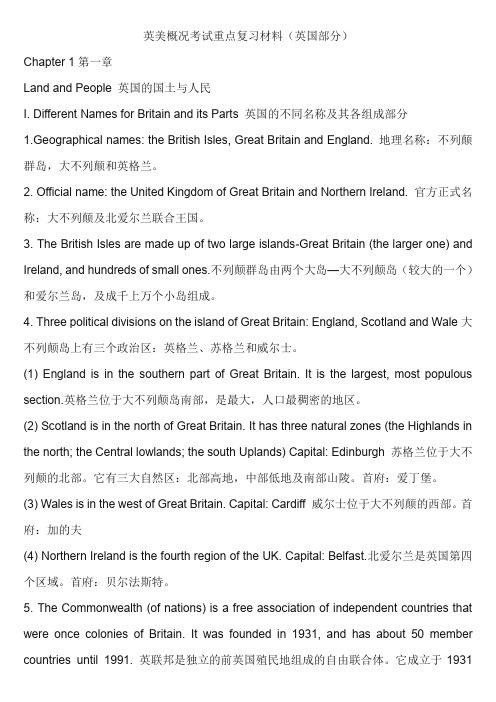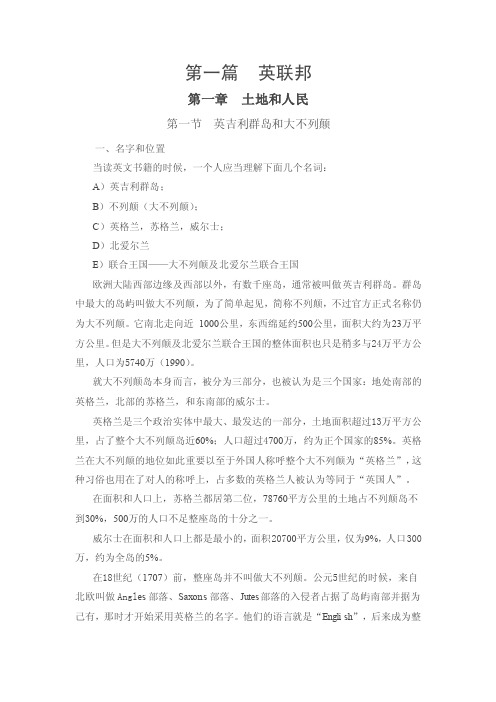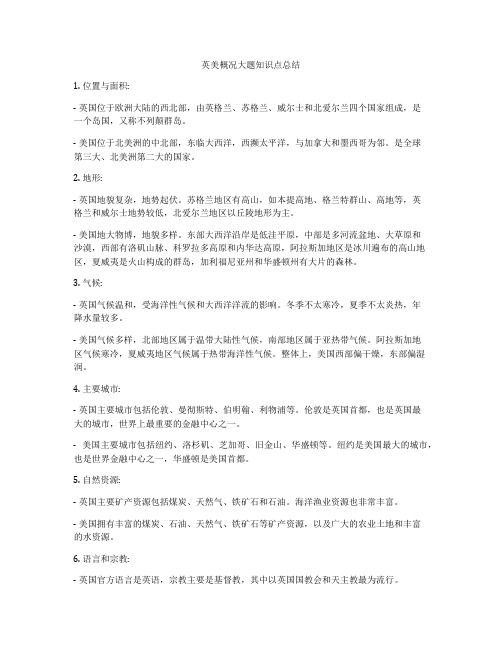英美概况资料
英美概况谢福之知识点总结

英美概况谢福之知识点总结英国和美国是世界上两个最具影响力和实力的国家之一,它们在政治、经济、文化等方面都具有重要的地位。
本文将对英美两国的政治制度、经济发展、文化特点等进行介绍,并分析两国之间的联系和影响。
一、政治制度英国是君主立宪制国家,国家元首是女王伊丽莎白二世。
国家由议会议员和内阁成员组成,议会分为上下两院,分别为众议院和贵族院。
议会具有立法权,内阁负责政府的运作。
英国政体具有稳定的政治体系和完善的法律制度,是世界上最早建立的议会制度国家之一。
美国是联邦制共和国家,国家元首是总统,由国会和总统共同行使立法权。
国会由参议院和众议院组成,总统负责执行国家政策和签署法案。
美国政体具有分权制衡、选举制度严格等特点,是世界上最早建立的共和政体之一。
二、经济发展英国是世界上最早工业化的国家,拥有发达的制造业和金融产业。
伦敦是世界金融中心之一,对全球金融市场具有重要的影响力。
英国的经济体系具有卓越的创新能力和国际竞争力,是世界上最具竞争力的经济体之一。
美国是世界上最大的经济体,拥有发达的制造业、服务业和高新技术行业。
美国是全球科技创新的领头羊,拥有世界上最多的科技研发机构和科技企业。
美国的经济体系具有活力和创新能力,是全球经济体系的重要推动力。
三、文化特点英国是世界上最具影响力的文化传统之一,拥有悠久的历史和丰富的文化遗产。
英国文学、音乐、戏剧等领域具有重要的地位,对世界文化产生了深远的影响。
英国的文化传统具有多样性和包容性,吸引着全世界的文化爱好者。
美国是一个多元文化的国家,拥有丰富多彩的文化传统和艺术表现形式。
美国文学、电影、音乐等领域对世界文化产生了深远的影响,美国的流行文化和大众文化在全球范围内具有重要的地位。
美国的文化传统具有包容性和开放性,吸引着全世界的文化创意者。
四、两国之间的联系和影响英国和美国有着深厚的历史渊源和文化联系,在政治、经济、文化等方面都具有紧密的联系和相互影响。
英国是美国的传统盟友,两国在国际事务和全球治理中保持着密切的合作关系。
英美概况考试重点复习材料(英国部分)

英美概况考试重点复习材料(英国部分)Chapter 1第一章Land and People 英国的国土与人民I. Different Names for Britain and its Parts 英国的不同名称及其各组成部分1.Geographical names: the British Isles, Great Britain and England. 地理名称:不列颠群岛,大不列颠和英格兰。
2. Official name: the United Kingdom of Great Britain and Northern Ireland. 官方正式名称:大不列颠及北爱尔兰联合王国。
3. The British Isles are made up of two large islands-Great Britain (the larger one) and Ireland, and hundreds of small ones.不列颠群岛由两个大岛—大不列颠岛(较大的一个)和爱尔兰岛,及成千上万个小岛组成。
4. Three political divisions on the island of Great Britain: England, Scotland and Wale大不列颠岛上有三个政治区:英格兰、苏格兰和威尔士。
(1) England is in the southern part of Great Britain. It is the largest, most populous section.英格兰位于大不列颠岛南部,是最大,人口最稠密的地区。
(2) Scotland is in the north of Great Britain. It has three natural zones (the Highlands in the north; the Central lowlands; the south Uplands) Capital: Edinburgh 苏格兰位于大不列颠的北部。
英美概况知识点总结归纳

英美概况知识点总结归纳英美概况是指英国和美国的文化、历史、政治、经济、教育等各方面的概况。
这两个国家在世界上具有重要的地位,对世界文化和政治产生了深远的影响。
下面将对英美概况的各个方面进行总结归纳。
一、文化概况1. 英国文化英国是一个拥有悠久历史的国家,其文化底蕴深厚。
英国文学自古至今在世界范围内具有重要地位,莎士比亚、狄更斯、奥斯丁等众多文学家的作品至今仍然备受人们喜爱。
英国音乐、戏剧、电影等领域也有着丰富的传统。
2. 美国文化美国是一个移民国家,因此其文化融合了来自世界各地的元素,呈现出多元化和包容性。
美国文学、音乐、电影等在世界上具有很大影响力,如杰克·伦敦、海明威、福克纳等作家的作品、爵士乐、摇滚乐、好莱坞电影等都深受人们喜爱。
3. 英美文化交流英美两国之间的文化交流十分频繁,互相影响。
英国音乐、戏剧、文学等在美国具有很大影响力,而美国的流行音乐、电影、文化现象也在英国广受欢迎。
二、历史概况1. 英国历史英国历史可以追溯到古代,罗马、盎格鲁-撒克逊、诺曼底人等不同民族和文化在英国留下了深远的影响。
英国从16世纪开始成为世界上的帝国大国,殖民了大量领土。
20世纪初,英国逐渐衰落,但仍然在政治、文化方面占有重要地位。
2. 美国历史美国历史相对年轻,但是却是一个充满传奇色彩的国家。
美国独立战争后成为独立国家,并在19世纪成为世界上最强大的国家之一。
20世纪,美国在两次世界大战后成为世界超级大国,对世界政治、经济产生了深远影响。
3. 英美历史关系英国曾是美国的殖民地,双方有着深厚的历史渊源。
美国革命后,两国保持了密切的关系,经济、文化、政治等方面有着广泛的交流合作。
三、政治概况1. 英国政治英国是一个君主立宪制国家,国家元首是君主,首相是政府首脑。
英国的政治体系成熟稳定,经过数百年的发展,形成了一套完善的议会制度和法律体系。
2. 美国政治美国是一个总统制国家,总统是国家元首和政府首脑。
英美概况中文版

第一篇英联邦第一章土地和人民第一节英吉利群岛和大不列颠一、名字和位置当读英文书籍的时候,一个人应当理解下面几个名词:A)英吉利群岛;B)不列颠(大不列颠);C)英格兰,苏格兰,威尔士;D)北爱尔兰E)联合王国——大不列颠及北爱尔兰联合王国欧洲大陆西部边缘及西部以外,有数千座岛,通常被叫做英吉利群岛。
群岛中最大的岛屿叫做大不列颠,为了简单起见,简称不列颠,不过官方正式名称仍为大不列颠。
它南北走向近1000公里,东西绵延约500公里,面积大约为23万平方公里。
但是大不列颠及北爱尔兰联合王国的整体面积也只是稍多与24万平方公里,人口为5740万(1990)。
就大不列颠岛本身而言,被分为三部分,也被认为是三个国家:地处南部的英格兰,北部的苏格兰,和东南部的威尔士。
英格兰是三个政治实体中最大、最发达的一部分,土地面积超过13万平方公里,占了整个大不列颠岛近60%;人口超过4700万,约为正个国家的85%。
英格兰在大不列颠的地位如此重要以至于外国人称呼整个大不列颠为“英格兰”,这种习俗也用在了对人的称呼上,占多数的英格兰人被认为等同于“英国人”。
在面积和人口上,苏格兰都居第二位,78760平方公里的土地占不列颠岛不到30%,500万的人口不足整座岛的十分之一。
威尔士在面积和人口上都是最小的,面积20700平方公里,仅为9%,人口300万,约为全岛的5%。
在18世纪(1707)前,整座岛并不叫做大不列颠。
公元5世纪的时候,来自北欧叫做Angle s部落、Saxons部落、Jutes部落的入侵者占据了岛屿南部并据为己有,那时才开始采用英格兰的名字。
他们的语言就是“Englis h”,后来成为整个国家的官方语言。
“Engl”这一部分来自“Angles”,“ish”意为“属于的东西”,整个“Englis h”的意思就是属于“Angles”的语言。
英美概况大题知识点总结

英美概况大题知识点总结1. 位置与面积:- 英国位于欧洲大陆的西北部,由英格兰、苏格兰、威尔士和北爱尔兰四个国家组成,是一个岛国,又称不列颠群岛。
- 美国位于北美洲的中北部,东临大西洋,西濒太平洋,与加拿大和墨西哥为邻。
是全球第三大、北美洲第二大的国家。
2. 地形:- 英国地貌复杂,地势起伏。
苏格兰地区有高山,如本提高地、格兰特群山、高地等,英格兰和威尔士地势较低,北爱尔兰地区以丘陵地形为主。
- 美国地大物博,地貌多样。
东部大西洋沿岸是低洼平原,中部是多河流盆地、大草原和沙漠,西部有洛矶山脉、科罗拉多高原和内华达高原,阿拉斯加地区是冰川遍布的高山地区,夏威夷是火山构成的群岛,加利福尼亚州和华盛顿州有大片的森林。
3. 气候:- 英国气候温和,受海洋性气候和大西洋洋流的影响。
冬季不太寒冷,夏季不太炎热,年降水量较多。
- 美国气候多样,北部地区属于温带大陆性气候,南部地区属于亚热带气候。
阿拉斯加地区气候寒冷,夏威夷地区气候属于热带海洋性气候。
整体上,美国西部偏干燥,东部偏湿润。
4. 主要城市:- 英国主要城市包括伦敦、曼彻斯特、伯明翰、利物浦等。
伦敦是英国首都,也是英国最大的城市,世界上最重要的金融中心之一。
- 美国主要城市包括纽约、洛杉矶、芝加哥、旧金山、华盛顿等。
纽约是美国最大的城市,也是世界金融中心之一,华盛顿是美国首都。
5. 自然资源:- 英国主要矿产资源包括煤炭、天然气、铁矿石和石油。
海洋渔业资源也非常丰富。
- 美国拥有丰富的煤炭、石油、天然气、铁矿石等矿产资源,以及广大的农业土地和丰富的水资源。
6. 语言和宗教:- 英国官方语言是英语,宗教主要是基督教,其中以英国国教会和天主教最为流行。
- 美国官方语言也是英语,宗教信仰多元,基督教、犹太教、伊斯兰教等都有一定的信徒。
英美历史概况:1. 古代历史:- 英国在古代分别由凯尔特人、罗马人、盎格鲁-撒克逊人和维京人等民族统治,1066年诺曼征服后建立了专制统治的王朝。
英语国家概况复习资料

英语国家概况复习资料英语国家概况复习资料英语国家概况是学习英语的重要一环,了解英语国家的历史、文化、地理等方面,有助于更好地理解和运用英语。
在这篇文章中,我们将回顾一些关于英语国家的基本知识,帮助大家复习和加深对这些国家的了解。
一、英国(United Kingdom)英国是英语的发源地,也是英语国家中最重要的一个。
它由四个国家组成:英格兰、苏格兰、威尔士和北爱尔兰。
英国是一个具有悠久历史和丰富文化的国家,拥有众多的文学、音乐和戏剧作品。
莎士比亚、狄更斯、毛姆等伟大的作家都出自英国。
此外,英国还有许多著名大学,如剑桥大学和牛津大学。
二、美国(United States)美国是世界上最大的英语国家之一,也是世界上最强大的国家之一。
它拥有丰富的资源和多元化的文化。
美国是一个移民国家,各种不同的文化和宗教在这里融合。
美国有众多著名的城市,如纽约、洛杉矶和芝加哥,每个城市都有其独特的魅力和特色。
此外,美国还是全球科技和创新的领导者,许多世界知名的科技公司都来自美国。
三、加拿大(Canada)加拿大是北美洲的一个国家,是英语和法语并存的国家。
加拿大是一个拥有广阔土地和丰富资源的国家,同时也是一个多元文化的国家。
加拿大的自然风光非常壮观,有着世界上最美丽的国家公园和湖泊。
此外,加拿大在教育和医疗领域也非常发达,拥有世界一流的大学和医疗系统。
四、澳大利亚(Australia)澳大利亚是一个位于南半球的国家,也是一个英语国家。
澳大利亚拥有宽广的土地和独特的动植物资源,是世界上最大的岛屿国家。
澳大利亚的自然环境非常独特,有着世界上最壮观的珊瑚礁和大堡礁。
此外,澳大利亚还以其高质量的教育和研究机构而闻名,吸引着来自世界各地的留学生。
五、新西兰(New Zealand)新西兰是一个位于南太平洋的岛国,也是一个英语国家。
新西兰的自然环境非常优美,有着壮丽的山脉、湖泊和海岸线。
新西兰是一个农业和旅游业发达的国家,其乳制品和葡萄酒在世界上享有盛誉。
英美概况知识点总结

英美概况知识点总结英美概况是指英国和美国的基本情况和特点。
英国是位于欧洲的一个岛国,由英格兰、苏格兰、威尔士和北爱尔兰四个国家组成,首都是伦敦。
美国则是位于北美洲的一个国家,由50个州组成,首都是华盛顿特区。
1. 地理位置英国位于欧洲西北部,东临北海,西濒大西洋,与法国相隔仅有英吉利海峡相隔。
美国则位于北美洲的中北部,东临大西洋,西濒太平洋,与加拿大相邻。
2. 历史文化英国是一个具有悠久历史的国家,拥有世界上最古老的君主制度。
英国文化对世界产生了深远的影响,包括文学、音乐、戏剧、电影等方面。
美国则是一个相对年轻的国家,但在短短几百年的时间里,美国发展成为世界上最强大的经济体和军事力量之一。
美国文化以自由、多元和创新为特点,融合了来自世界各地的移民文化。
3. 政治制度英国是一个君主立宪制国家,君主为国家元首,政府首脑为首相。
英国议会制度发源于英国,对世界各国影响深远。
美国则是一个联邦制共和国,总统为国家元首和政府首脑,国会为立法机关。
美国的总统制度也对世界其他国家的政治制度产生了影响。
4. 经济发展英国是一个高度发达的资本主义经济体,金融、服务业和创新产业是其经济的支柱。
英国拥有伦敦金融城,是全球金融中心之一。
美国则是世界上最大的经济体,以市场经济为基础,拥有发达的制造业、科技产业和金融服务业。
美国的股市和创新科技企业在全球具有重要地位。
5. 教育体系英国拥有全球顶尖的大学,如剑桥大学和牛津大学,以及众多优秀的高中和中学。
英国教育体系注重学术传统和素质教育。
美国则拥有世界上最多的大学和研究机构,美国的教育体系注重实践和创新,鼓励学生个性发展。
6. 社会福利英国实行社会福利制度,医疗、教育、退休金等福利待遇相对较高。
美国的社会福利制度相对较少,个人的社会保障和福利待遇更多依赖于个人努力和私人保险。
7. 文化特色英国有悠久的文化传统,包括皇室、茶文化、乡村庄园、英式足球等。
美国则是一个多元文化的国家,融合了来自世界各地的移民文化,美国足球、篮球、好莱坞电影等都是美国文化的代表。
英美概况第二版

THANK YOU
感谢各位观看
和技能培训。
02
美国教育改革
美国教育改革关注提高教育质量、缩小教育差距、促进教育公平等议题,
同时推动STEM教育和职业教育的发展。
03
发展趋势
英美两国都在积极探索教育创新,注重培养学生的创新能力和实践能力,
以适应快速变化的社会需求。同时,两国都在加强国际交流与合作,推
动教育的国际化发展。
05
英美文学与艺术概览
国际贸易,对外投 资,吸引外资
教育体系
高等教育,职业教 育,中小学教育
Байду номын сангаас3
美国概况
美国历史与文化
美国的起源与历史发展
美国的文学、艺术与音乐
从13个殖民地的建立到独立战争,再 到西进运动、南北战争等关键历史节 点。
如马克·吐温、海明威等文学巨匠,以 及好莱坞电影、百老汇音乐剧等艺术 成就。
美国的多元文化
美国经济与社会发展
美国的经济发展历程
01
从工业革命到现代经济体系的建立,包括农业、制造业、服务
业等产业的发展。
美国的社会福利制度
02
如社会保障、医疗保险、失业保险等制度的建立和实施情况。
美国的教育与科技
03
包括高等教育、科研创新等方面的成就和挑战,以及硅谷等科
技中心的崛起。
04
英美教育制度比较
教育理念与特点比较
英国概况
英国历史与文化
中世纪英国
文艺复兴时期
盎格鲁-撒克逊人的入侵, 诺曼征服,中世纪的封
建制度
伊丽莎白时代,莎士比 亚的戏剧,英国文艺复
兴的成就
工业革命
纺织机的发明,蒸汽机 的应用,工业革命的影
- 1、下载文档前请自行甄别文档内容的完整性,平台不提供额外的编辑、内容补充、找答案等附加服务。
- 2、"仅部分预览"的文档,不可在线预览部分如存在完整性等问题,可反馈申请退款(可完整预览的文档不适用该条件!)。
- 3、如文档侵犯您的权益,请联系客服反馈,我们会尽快为您处理(人工客服工作时间:9:00-18:30)。
1. The longest river in Britain is ____.A. SevernB. TeesC. ThamesD. Clyde2. The British Isles is made up of ____.A. Three large islands and hundreds of small onesB. Two large islands and hundreds of small onesC. Three large islands and dozens of small onesD. Two large islands and dozens of small ones3. There are three political divisions ____ on the island of Great Britain.A. England, Scotland, and IrelandB. England, Scotland, and WalesC. England, Scotland, and Northern IrelandD. Northern Ireland, Wales and Scotland4. The Tower of London, located in the centre of London, was built by ____.A. King HaroldB. William the ConquerorC. Robin HoodD. Oliver Cromwell5. St. Paul’s Cathedral is in ____.A. LiverpoolB. LondonC. GlasgowD. Birmingham6. The largest lake in Britain is ___.A. UllswaterB. Loch LomondC. WindermereD. The Lough Neagh7. The Romans led by Julius Caesar launched their first invasion on Britain in ____.A. 200B.C. B. 55 A.D. C. 55 B.C. D. 410 A.D.8. The capital of Northern Ireland is ____.A. BelfastB. BirminghamC. EdinburghD. Cardiff9. Between 1337 and 1453 the ____ took place in Britain.A. Wars of RosesB. Black DeathC. Hundred Year’s WarD. Peasants Uprising10. The first Civil War in Britain lasted from ____ to ____.A. 1600—1604B. 1640—1644C. 1642—1646D. 1646—165011. James Watt created a ____ in 1769.A. Spinning MuleB. Steam EngineC. Power LoomD. Spinning Jenny12. In English individualistic culture, one should not bother Englishmen without a good reason and making appointment beforehand seems to be important. It is best reflected by an English proverb____.A. as welcome as a stormB. an Englishman’s house is his castleC. do not wear out your welcomeD. outstay one’s welcome13. ____ is the first weekday after Christmas, a legal holiday in English, Wales, Northern Ireland, New Zealand, Australia and South Africa.A. Thanksgiving DayB. Anzac DayC. St. Valentine’s DayD. Boxing Day14. The Bible was originally written in ____. CA. LatinB. EnglishC. HebrewD. Arabic15. Which of the following king was executed in the civil war?A. James IB. Charles IC. James IID. Charles II16. From 1649 to 1658 English was called a Commonwealth. It was ruled first byOliver Cromwell as ____ .A. PresidentB. Lord ProtectorC. Lieutenant GeneralD. Commander of the New Model Army17. A “vote of no confidence” is decided by ____.A. the House of LordsB. the Prime MinisterC. the House of CommonsD. the two major parties18. British English is spoken is ____.A. Great BritainB. AustraliaC. New ZealandD. A, B, and C19. Eton College is a famous ____ of UK.A. collegeB. comprehensive schoolC. public schoolD. university20. Westminster Palace is the ____.A. seat of British House of ParliamentB. seat of English churchC. residence of king and QueenD. residence of Prime Minister21. No. 10 Downing Street is ____.A. Office of British NavyB. official residence of Prime MinisterC. seat of English ParliamentD. official residence of King22. Big Ben is the nickname of ____.A. Sir Benjamin HallB. Benjamin FranklinC. 315-foot Clock TowerD. Sir Charles Barry23. Which of the following is by far the most influential in the West? ____. AA. ChristianityB. BuddhismC. IslamismD. Judaism24. Stratford-on-Avon is a famous place where ____ was born. BA. John MiltonB. William ShakespeareC. Ben JohnsonD. Thomas Gray25. The oldest university in Britain is ____. CA. Sunday TimesB. St. Andrews UniversityC. OxfordD. Edinburgh University26. The Tories were the forerunners of ____, which still bears this nickname today. CA. the Liberal PartyB. the Labor PartyC. the Conservative PartyD. the Social Democratic Party27. Halloween is celebrated on ____. DA. 5TH NovemberB. 17th MarchC. 25th DecemberD. 31st October28. Easter is a holiday usually connected to the following except____. CA. the coming of springB. the eating of Easter eggsC. the reunion of a large familyD. the resurrection of Christ29. The most famous broadcasting company in Britain is ____. BA. Independent Broadcasting AuthorityB. British Broadcasting CorporationC. Radio TimesD. Reuters30. Today, the City of London is the business centre of London where you can find ____. CA. big supermarketsB. theatres and cinemasC. large financial organizationsD. restaurants and cafes31. In the United Kingdom, the party which wins the ____ number of seats in the House of Commons becomes the official Opposition. DA. largestB. third largestC. fourth largestD. second largest32. In Britain, ministers are appointed by the Queen on the recommendation of ____. BA. the Lord ChancellorB. the Prime MinisterC. the SpeakerD. the Parliamentary Commissioner33. Which of the following is the world’s oldest national newspaper? DA. The TimesB. The GuardianC. The SunD. The Observer34. The real centre of power in the British Parliament is ____. BA. the King or the QueenB. the House of CommonsC. the House of LordsD. the Cabinet35. The oldest part of British Parliament is ____. AA. the House of LordsB. the House of CommonsC. the Shadow of CabinetD. the Chamber36. The national centre of the press in Britain is ____. DA. Great Russell StreetB. Speaker s’CornerC. Downing StreetD. the Fleet Street37. Among the most typical English sports, having been in existence since the 16th century, is__ B.A. rugbyB. cricketC. boxingD. football38. The Gothic style started in ____ and quickly spread through all parts of western Europe. AA. FrenchB. EnglishC. HebrewD. Germanic39. The world’s largest freshwater lake is Lake ____. AA. SuperiorB. OntarioC. HuronD. Michigan40. The state of ____ is rich in fishing and trapping. CA. HawaiiB. CaliforniaC. AlaskaD. New York41. Harvard University was founded in ____. CA. 1366 B 1633 C. 1636 D. 136342. The state to which the Mayflower sailed is ____. DA. FloridaB. MaineC. VirginiaD. Massachusetts43. The U.S.A. is known as a “Melting Pot” for its ____.AA. mixture of nationalitiesB. mixture of climatesC. mixture of habitsD. mixture of religions44. ____ is regarded as the cradle of the Renaissance? BA. GreeceB. ItalyC. GermanyD. England45. Who was the first woman Prime Minister in British history? CA. Elizabeth IB. Elizabeth IIC. Margaret ThatcherD. Diana Princess of Wales46. The important thing done in the Second Continental Congress was that ____. DA. the Declaration of the Independence was signed.B. the Revolutionary War endedC. a new government was discussedD. Washington was appointed commander of the army47. In the Civil War, Lincoln issued the famous ____ BA. the Bill of RightsB. the Emancipation ProclamationC. the Federalist PaperD. the Declaration of Independence48. The “Big Stick” Policy was advanced by President____. DA. Franklin D. RooseveltB. William MckinleyC. Thomas Woodrow WilsonD. Theodore Roosevelt49. What is the largest river in America? CA. The Ohio RiverB. The ColumbiaC. The Mississippi RiverD. The Colorado50. The United States is ____ populous country in the world. AA. the third mostB. the second mostC. the mostD. the fourth most51. In Jan. 1918, American President ____prepared his “Fourteen Point” as a basis of peace negotiation. AA. Woodrow WilsonB. William H. TaftC. WarrenD. Harding52. President Franklin D. Roosevelt proposed a well-known policy called ____ to save the economic situation. DA. the Open Door PolicyB. the “Big Stick”C. Good Neighbor PolicyD. the New Deal53. The Declaration of Independence was drafted by ____.AA. Thomas JeffersonB. George WashingtonC. Benjamin FranklinD. John Adams54. The period of the “Cold War” began when ____ came forth in March 1947. CA. NATOB. The Eishenhower DoctrineC. The Truman DoctrineD. Marshall Plan55. Who was considered as father of modern astronomy and put forward his theory that the sun, not the earth, is the centre of the universe? AA. CopernicusB. KeplerC. GalileoD. Newton56. The largest public library in the U.S. is ____ . BA. library of HarvardB. Library of CongressC. Franklin LibraryD. Roosevelt Library57. The 1920s in the United States has been described as a period of ____. DA. cultural revivalB. loss of purposeC. development in science and technologyD. material success and spiritual frustration58. ____ is considered America’s unique contribution to music. AA. JazzB. Rock and RollC. Country MusicD. Western Music59. Whose discovery of the law of the universal gravitation is the most important of all his achievements in physics? BA. KeplerB. Issac NewtonC. GalileoD. Copernicus60. The three biggest newspapers are of the following except____. DA. New York TimesB. Washington PostC. Los Angeles TimesD. Reader’s Digest61. Metropolitan Museum is in ____. CA. Washington D.C.B. BostonC. New YorkD. Philadelphia62. Who resigned because of Watergate Scandal, the first president to do so in American history?CA. KennedyB. JohnsonC. Richard NixonD. Truman63. Empire State Building is in ____.A. ChicagoB. New YorkC. WashingtonD.C. D. Detroit64. “Knowledge is power.” was said by ____.AA. Francis BaconB. ShakespeareC. Thomas HobbesD. John Locke65. Which of the following philosophers believed that man is selfish by nature? DA. John LockeB. DescartesC. Pierre GassendiD. Thomas Hobbes66. Jazz, a great contribution to the world popular music, was originated from the music of ____.CA. IndiansB. SpanishC. NegroesD. Portuguese67. Which of the following philosophers ever said “I think, therefore I am”? ____. BA. Francis BaconB. DescartesC. Pierre GassendiD. John Locke68. American Presidents are elected ____. BA. every two yearsB. every four yearsC. every five yearsD. every six years69. Which branch of American government has the power to interpret the Constitution?AA. The Supreme CourtB. The PresidentC. The HouseD. The Senate70. The American Constitution is the oldest written constitution in the world. It was drawn up in ____.DA. 1778B. 1783C. 1774D. 178771. Whose doctrines of the separation of powers became one of the most important principles of the U.S. Constitution? BA. John LockeB. MontesquieuC. RousseauD. V oltaire72. The Gettysburg victory was the turning point of ____. AA. The Civil WarB. the war of IndependenceC. the Indian WarD. the Trenton War73. The functions of institutions of higher education in the U.S. are ____. DA. research and teachingB. teaching and degree awardingC. professional training, teaching and public serviceD. teaching, research and public service74. Who ever said that “Lost time is never found again”and “God helps those who help themselves”? DA. John LockeB. V oltaireC. MontesquieuD. Benjamin Franklin75. ____ is not a nationally observed holiday of America.AA. Easter SundayB. Veterans’ DayC. Independence DayD. Christmas76. The theme of Thanksgiving has always been____.BA. friendship and happinessB. peace and plentyC. cooperation and rich awardD. love and happiness77. When was the Declaration of Independence adopted by the Continental Congress? CA. On July 2, 1776B. On June 4, 1776C. On July 4, 1776D. On July 6, 177478. The city’s name, “Philadelphia” means ____. CA. fishing pitB. waste landC. brotherly loveD. wild land79. ____ has been called the “cradle of American liberty”. BA. BostonB. PhiladelphiaC. PlymouthD. Chicago80. How many continental states were there at the time of independence of the United States?AA. 13B. 53C. 48D. 3581. Who said “I have a dream”? DA. Benjamin FranklinB. Francis BaconC. LincolnD. Martin Luther King。
